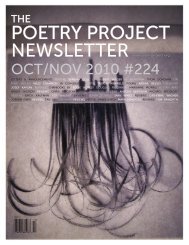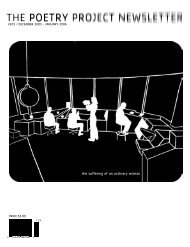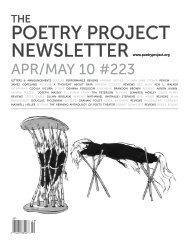10 FEB/MAR 11 #226engagement with the Bay Area avant poetry scene (what he liked to call“the writing community”) had almost completely burned off, leaving a manvulnerable to ghosts of the past—ghosts that once were passions—andlooking for the next involvement, the thing that would lift him up again. Hetold me he’d been dating a nurse, one of many he knew at the medicalcenter where he went for his weekly blood check. He was on a chemicalleash that got shorter and heavier with each passing year—coumadin forhis blood (he had a plastic heart valve), analgesics for his migraines, valiumfrom his therapist, and toward the end, a disastrous round of interferon(which he stopped) for Hep C. This last diagnosis, made in his last year,was I think the last straw. As the entitlement era drew to a close and hisSSI checks became more restrictive and he had to pay for his meds moreand more out of his pocket, he must have sensed that the future wastrying to head him off. Brice Marden talks about new beginnings that seemsuffused with hope but which eventually turn out to be labyrinths that leadonly backward—I wonder if Dan hadn’t also begun to feel that way. Andyet during one of our chats, when I was ineptly trying to commiseratewith him, saying something to the effect that life was hard with occasionalpatches of brightness, he stopped me short. What do you mean, he said,life has great swatches of brightness, towering heights of beauty and joy.Dan was the first poet I’d ever met who lived his life as <strong>The</strong> Poet, withno interference from a day job or schedule, save weekly and/or monthlyvisits to various clinics. He worked very hard on his poetry—after fifteenyears, some of it still searches along a hard edge. He also worked hard todevelop, if I can put it this way, his deportment—his self-presentation as aprofessional and engaged artist. Looking at “deportment” makes me seethat it could apply to Dan in more ways than one. With his uncompromisingapartness he was indeed “deported” from run-of-the-mill America, takingnone of its pleasantries for granted, and always at odds with those whodid, or could. (“Don’t I look acculturated?” he once asked when he showedme a photo of himself and his then-girlfriend Jenny, followed by his highpitchedlaugh.) And he was also “deported” from the world in whichbeing an engaged poet could mean something, could be a fact worthy ofattention, if not automatic respect—as happens (used to happen?) in theworld surrounding North America. So if his deportment were also thesethings, they were part of the background of his active deportment—thestyles he chose in facing down such a world. Remembrances turn intoanecdotes when I think about Dan, but I also remember him in his rattycane chair in the flat on lower Haight (gotten off the street like everythingelse in the flat), on the phone to poet A quietly suggesting that poet B,who was close to poet C, be included among the poets speaking at C’smemorial. Likewise the sense of company he provided, his enthusiasmsand despairs, his fearsome intelligence, his pitiless debater’s will, hisadvice on where to send submissions, and how.1.) Always have something in the mail.2.) Never fold your work. <strong>The</strong> SASE should be larger than 8½ x 11, andthe original mailing envelope even larger. <strong>The</strong>re’s a subtle difference if it’sfolded. And if you get it back it’s still uncreased and you can send it to thenext place down the line.He also wrote two computer rules for Gary Sullivan on an index card, whenGary, a mutual friend, got his first PC:1.) Turn it off before the brain melts.2.) Think—Plan—Attack!We finally got together in the present, the present that was now over tenyears ago, after one plan after another snagged—with Dan, you alwayshad to be prepared for plans to fall through. We hadn’t seen each otherfor a few years. I’d moved somewhere else, he was still (as always) onlower Haight, living his hand-to-mouth existence in digs he called “theAnarchy Arboretum” with a couple of steadfast roommates. I met him atmy door, and was startled at his shoulder-length hair—he’d always wornit short. Our mutual wariness remained, and there were no handshakes orhugs, but up in my flat we started catching up and things seemed warm.One of his friends, a woman he had been at school with, mentioned athis memorial that one of the ways he’d changed from the last time they’dbeen together was that he blinked slower. And that’s what he did thatafternoon in my flat: he blinked slower. At one point I mentioned a recentmugging, my first. It had been bad (clubbing, etc.) and as I was in themiddle of my account I saw big tears rolling down his cheeks. He got up, Igot up, and we embraced, Dan squeezing with all his strength.He’d turned a corner. Dan had always been a mix of the almostirrationally combative and an almost equally perplexing vulnerability. Butthe combativeness had pretty much disappeared (the battles he chosewere always uphill ones, and how long can that be sustained?), leavingthe vulnerability and lostness. In the past, your desire to shelter him wasalways at war with the things he would do or say that made you feel youhad to take him on. Now, shelter was everything.I wish I could say we were able to resume our former closeness, butthis was not to be. In addition to our past troubles, the hiatus of a fewyears had made a change in our orbits—we had different friends, differentprojects, different perspectives. And there was the time factor: I had a fulltimejob and was often too beat to do much in my spare time (Dan wasn’tsomeone you could chill with), whereas he lived on disability checks andhad an open calendar. <strong>The</strong> irony, if that’s what it is, is cruel and stupid: I,with very little free time, am writing this ten years later; while Dan, who hadso little time left, had all the time in the world.<strong>The</strong> evening after he smothered himself his roommate Miguel and I wrotehis obituary together over the phone. We were hoping to get it into theproper obit page in the Chronicle, but it ended up in the paid listings, the feepaid for by one of Dan’s teacher friends. Miguel and I stumbled over howto describe Dan’s non-poetry “activities.” We finally settled on “iconoclasticsocial activist,” with a bit of tongue in our cheek (though Dan would haveunhesitatingly agreed). Activism of a kind it certainly was. Once he strolledinto a Nordstrom and lingered near a display table of high-end cosmeticitems just long enough to surreptitiously deposit a professional-lookingsign he’d made at home which said FREE—TAKE ONE. Pranks like thesewere warm-ups for his most elaborate hoax, a bogus Bart Bulletin whichhe’d done up on his computer to look like the real thing, and which statedthat, due to the current oil crisis, Bart had been compelled to “review itsservices.” After a few public relations paragraphs that agonized over thedifficult decisions Bart had to face during such a shortage, the bulletin
THE POETRY PROJECT NEWSLETTER11dropped the other shoe and said that it would be forced to raise faresby 80%—and all senior and handicapped fares would be discontinued.He took the original and photocopied a ream of these bulletins; thendescended the stairs of the 16 th and Mission Bart station and fearlesslydeposited them in the Bart Bulletin receptacles, using his long overcoatto shield what he was doing from the security cameras, then went homeand waited for the shit to hit the fan. Alas, this cherry bomb turned out tobe a dud—after a few people called the administration offices to protestthis new policy, the bulletins were found and pitched, and that was that.Though Dan relished confrontation and courted it more aggressively thananyone I’ve ever known, some of his oppositionality could be conventional.During the first Gulf War he made a simple 8x11 page, which said simplySAY NO TO WAR, in big caps that filled the sheet, then made copies andput and plastered them everywhere—on retail bulletin boards, stacked incafés, left in magazines at newsstands. People would find them and putthem up in their homes. You’d take the bus and see the signs in apartmentwindows all over San Francisco.His subtlest move, conceived and carried out during that first Gulf War,was also the one most deserving of “iconoclastic social activism.” It wasa small rectangular pin the size of a stick of Dentyne, worn on your shirtand bearing a single word: IRAQI. Dan wore his pin all the time and madethem for anyone who wanted one. I don’t know if Dan knew the workof Guy Debord (I suspect not, since he never mentioned Debord, andhe mentioned everything) but his IRAQI pin was the perfect Situationistgesture. Transforming himself into a walking signifier of either a declaredenemy “overseas” or a helpless civilian caught between two power-thugs,he forced people viscerally to have a view, and if they had one already, toassess and declare it. Strolling through the Financial District, down chi-chiUnion and its phalanx of boutiques, or any neighborhood in the city thathad a well-greased notion of the good life in America, Dan was a walkingrip in the texture. He worked the effect of statement made away from aplatform and dropped into the gaps of everyday living: if you can’t bringthe war home you can at least create a flash point that made avoidanceof the discussion impossible. <strong>The</strong> hostility he provoked with this little pinwas remarkable to behold. What’s that supposed to mean, people wouldask. What do you think it means, he asked them back. Even people notdisposed to favor the war could be put off by the line in the sand, and forDan a person polarized by such activities was a person jarred into seeingthe picture whole (though this was an outcropping of one of his worstbeliefs, that only polarized positions are deeply held).Dan exemplified the spirit of the WWI-era avant-garde more than anyoneI knew, and he felt the attendant pressurization. True avant-gardists aresoldiers, working in ways that incur risk and casualty. Every successfulgesture is further proof of the imperturbability of the mass. James Baldwinsaid that his writing was directed not toward the unconscious ones, whowere probably beyond influence, but toward the relatively conscious, theones who might be capable of dilating their perspective. Dan never madethis distinction (he would have seen it as timidity) with the result that everyincursion, even one that felt like a victory, was also a solitary head beatingagainst a wall.Not that the last life has been taken its formshold and tend passage held in the light of handa sweetening in the eyes a drinkingthat lays answeringlending a final portion squeezed out of debtin the relationship of the overlooked a shapingof the personalnot to have a clock bringing its share.<strong>The</strong>se opening lines from “Bureaucrat, My Love”, Dan’s best poem, seemto be counting down the seconds even as they reference sweetening andlight. Written four years before he died, it’s far from his last poem (somespiky, directly topical work was still to come) but it’s the poem that seems,in my view, the one most haunted by a future reckoning he will never know.Something is being gathered and rehearsed.Building on an idea of Nietzsche, Massimo Cacciari speaks of “posthumouspeople,” artists and thinkers whose effect on others happens only aftertheir death. “<strong>The</strong>y are misunderstood more than others, more than actualpeople. And yet they are heard better (…) <strong>The</strong> ghosts of posthumouspeople practically force themselves to be heard, practically cause thedimension of hearing to be rediscovered.” And yet this is surely a beliefamong the living, among poets—not as posterity but as the message inthe bottle, as transmission to an imagined distant listener, who may turnout in the end to be only a future one. Dan’s “relationship of the overlooked”is of this process. <strong>The</strong> overlooked could be the poet but could also be theunfound thought or preoccupation the poet is trying to pass to others,who may be able to take on the urgent whisperings in the poem andsynthesize some of its nature in their own time on earth. <strong>Poetry</strong>-making,with its investment in imaginal and semantic complexes as bearers ofhope, is also at times an act of mourning. Poets as posthumous peopleare the ones who consolidate and commemorate the loss of nature. <strong>The</strong>yremember, then remember remembrance. And they also know that thisis not one-directional. Reflection beams forward as much as it sifts downonto spent time.Dan, my love, difficult and brilliant friend, you are remembered.. . .Notes: Previous versions of this excerpt have appeared in Mirage #4Period(ical), issue 134 (September 2006), edited by Dodie Bellamy and KevinKillian; and on Michael Cross’s blog, <strong>The</strong> Disinhibitor (http://disinhibitor.blogspot.com). Much thanks to these editors.Daniel Davidson’s culture (Krupskaya) and Image (Zasterle) can be orderedfrom Small Press Distribution (www.spdbooks.org). Sections of culture notincluded in Krupskaya’s print edition can be accessed at the Krupskayawebsite at: www.krupskayabooks.com/culture2.pdf.George Albon’s most recent book is Momentary Songs (2008), fromKrupskaya. Chapbooks from Envelope and Albion Books will appear laterin the year. <strong>The</strong> above recollection is from Cafe Multiple, a prose workin progress.
















